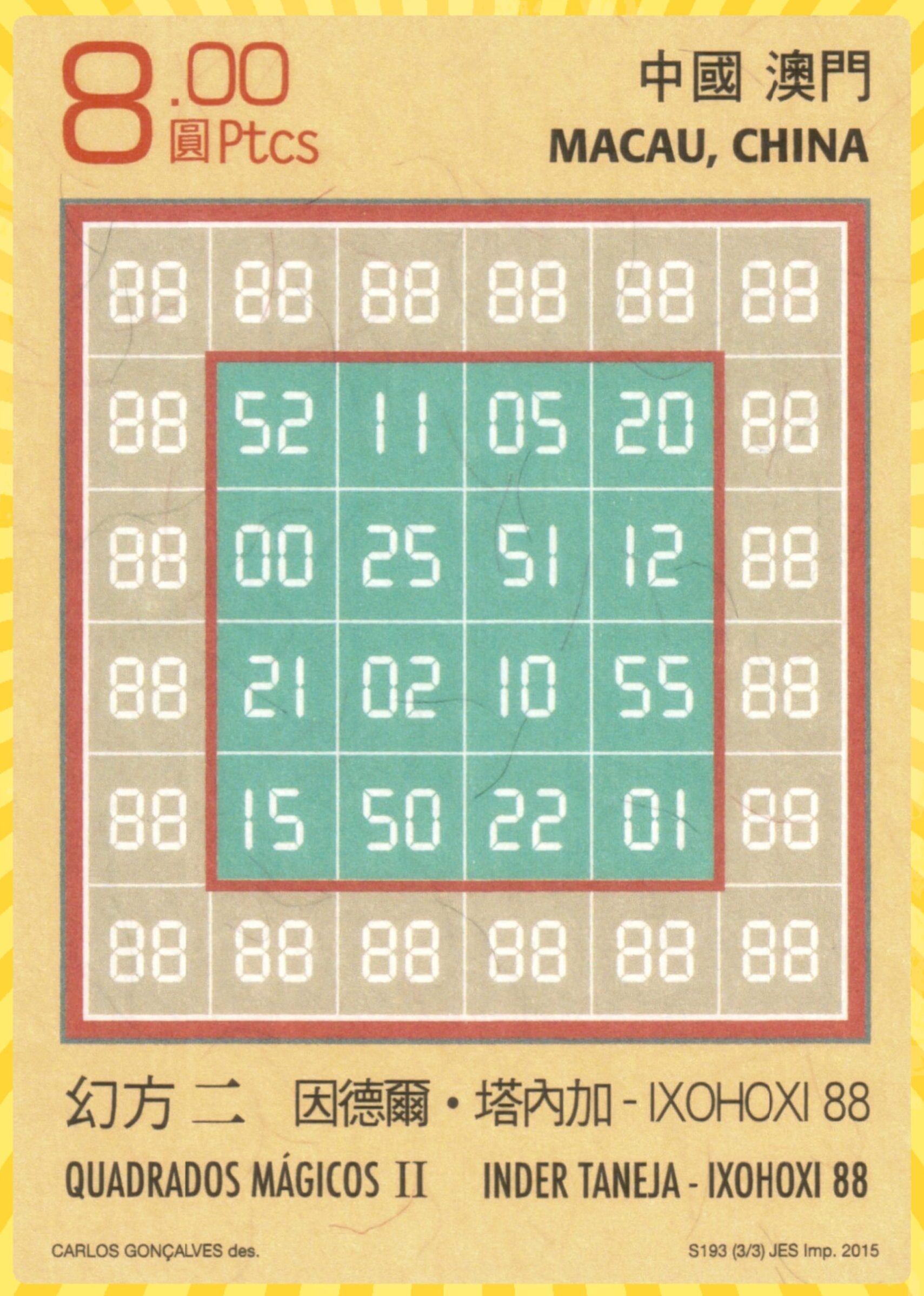There are many ways of representing magic squares with palindromic type entries. Also, we can write magic squares in the composite forms based on pair of Latin squares. This paper works with magic and bimagic squares of order 16. By upside-down, we understand than by making 180o it remains same. When the magic square is of both type, i.e., upside-down and mirror looking, we call it as universal magic square. By mirror looking, we understand that putting in front of mirror, still we see the image as a magic square. In case of mirror looking, writing as digitais fonts, 2 becoms 5 and 5 as 2. In case of upside-down, 6 becomes 9 and 9 as 6.
This work brings examples in different categories of entries. These are based on blocks of magic squares of orders 3, 4, 6 and 8. In some cases the these blocks are pandiagonal magic squares. The blocks of order 3 are always semi-magic squares.
- 4-Digits Cell Entries
- In this case, the work is in 5-digits, such as, (0,1,6,8,9) and (0,1,2,5,8). 5-Digits combinations lead us to 4-digits cell entries. This part bring us upside-down and universal pandiagonal bimagic squares of order 25, where the blocks of order 5 are pandiagonal magic squares of equal magic sums.
- 6-Digits Cell Entries
- In this case, the work is in 3-digits, such as, (1,6,9) and (2,5,8). 3-Digits combinations lead us to 6-digits cell entries. This part bring us upside-down and universal pandiagonal magic squares of order 25. In this case, still, we don’t have bimagic squares. The blocks of order 5 are pandiagonal magic squares with different magic sums.
- 10-Digits Cell Entries
- In this case, the work is in 2-digits, such as, (1,8), (2,5) and (6,9). 2-Digits combinations lead us to 10-digits cell entries. This part bring us upside-down and universal pandiagonal magic squares of order 25, where the blocks of order 5 are pandiagonal magic squares of different magic sums.
- 12-Digits Cell Entries
- In this case, the work is in 2-digits, such as, (1,8), (2,5) and (6,9). 2-Digits combinations lead us to 12-digits cell entries. This part bring us upside-down and universal pandiagonal bimagic squares of order 25, where the blocks of order 5 are pandiagonal magic squares of equal magic sums.
For complete work on universal and upside-down magic, bimagic and pandiagonal squares of orders 3 to 25 except the orders 17, 18, 19, 22 and 23 see the reference list given at the end of this work.
More details of this work are given in following online work:
- Inder J. Taneja, Universal and Upside-Down Magic Bimagic Squares of Order 25, Zenodo, October 30, 2024, pp. 1-43, https://doi.org/10.5281/zenodo.14014851.
Universal and Upside-Down
Magic and Bimagic Squares of Order 25
a) 4-Digits Cell Entries:
Upside-Down Magic Square with 5-Digits (0,1,6,8,9)
Example 1: Upside-Down Pandiagonal Bimagic Square of Order 25
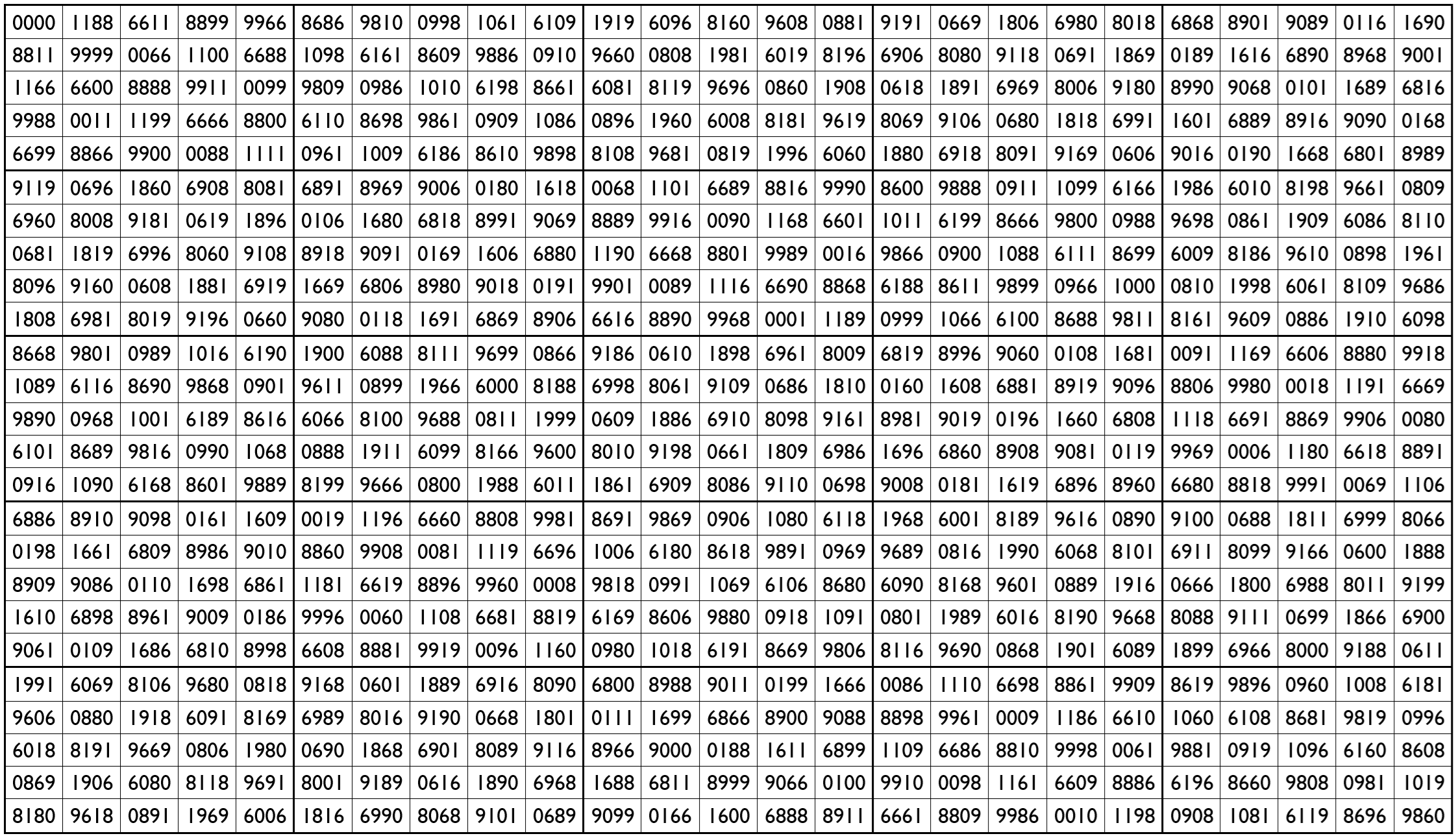
It is upside-down pandiagonal bimagic square with magic and bimagic sums:
S25×25(0,1,6,8,9):=133320
Sb25×25(0,1,6,8,9):=1048342630
Blocks of order 5 are pandiagonal magic squares with equal magic sums:
S5×5(0,1,6,8,9):=26664
Universal Magic Square with 5-Digits (0,1,2,5,8)
Example 2: Universal Pandiagonal Bimagic Square of Order 25
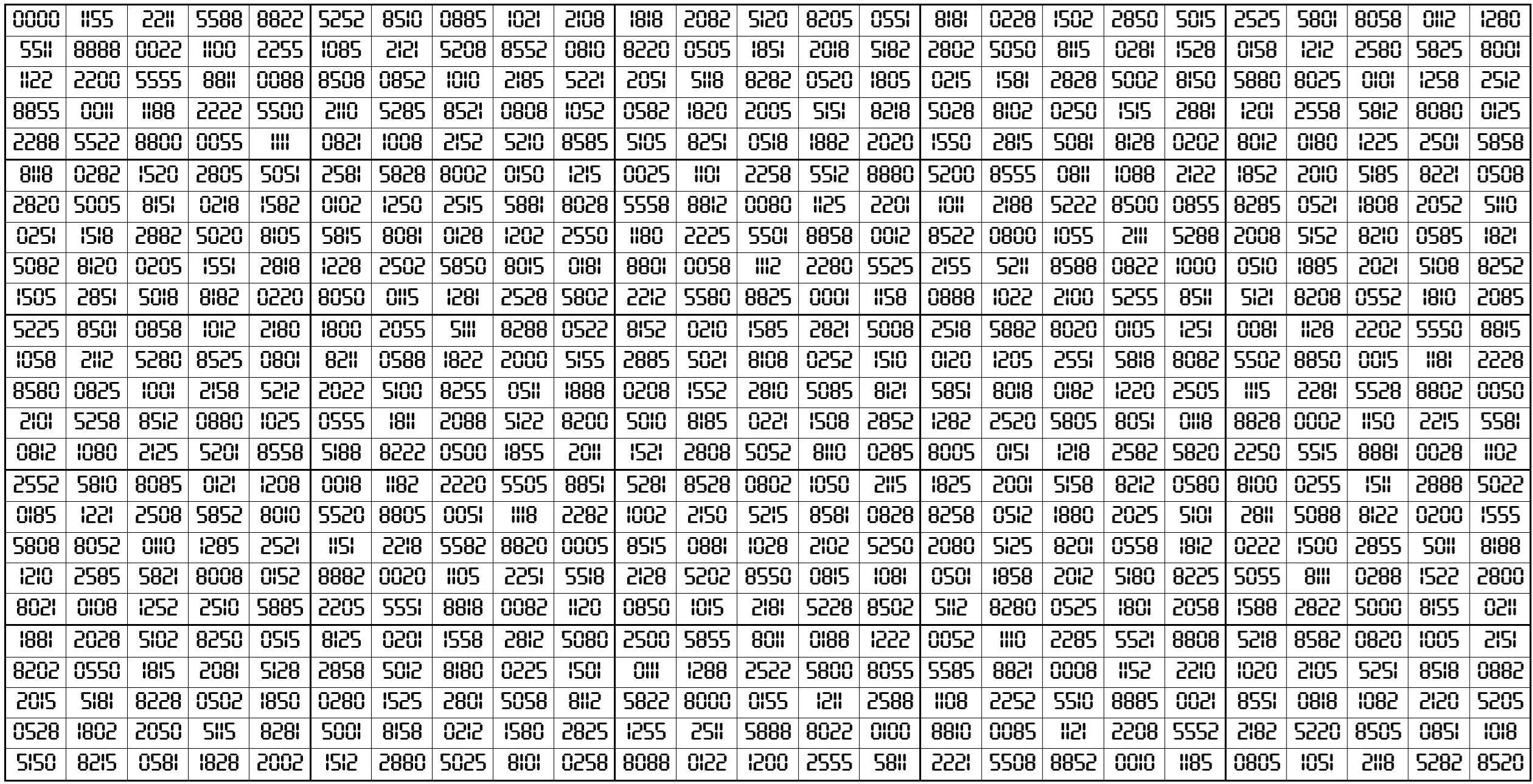
It is universal pandiagonal bimagic square with magic and bimagic sums:
S25×25(0,1,6,8,9):=88880
Sb25×25(0,1,6,8,9):=532147790
Blocks of order 5 are pandiagonal magic squares with equal magic sums:
S5×5(0,1,6,8,9):=17776.
b) 6-Digits Cell Entries:
Upside-Down Magic Squares with 3-Digits (1,6,9)
Example 3: Pandiagonal Magic Square of Order 25
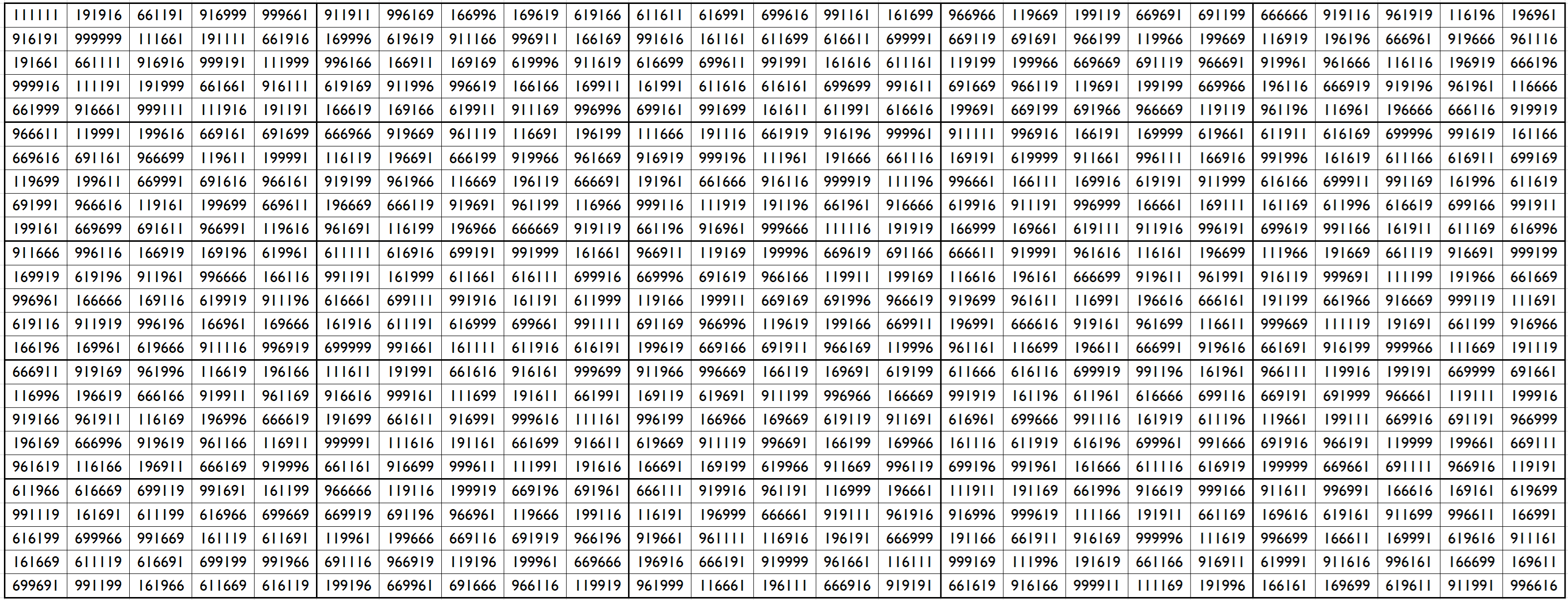
It is upside-down pandiagonal magic square with magic sum:
S25×25(1,6,9):=14333319
Blocks of order 5 are pandiagonal magic squares with different magic sums.
Universal Magic Squares with 3-Digits (2,5,8)
Example 4: Pandiagonal Magic Square of Order 25

It is universal pandiagonal magic square with magic sum:
S25×25(2,5,8):=14222208.
Blocks of order 5 are pandiagonal magic squares with different magic sums.
c) 10-Digits Cell Entries:
Universal Magic Squares with 2-Digits (1,8)
Example 5: Pandiagonal Magic Square of Order 25

It is universal pandiagonal magic square with magic sum:
S25×25(1,8):=128888888876
Blocks of order 5 are pandiagonal magic squares with different magic sums.
Universal Magic Squares with 2-Digits (2,5)
Example 6: Pandiagonal Magic Square of Order 25
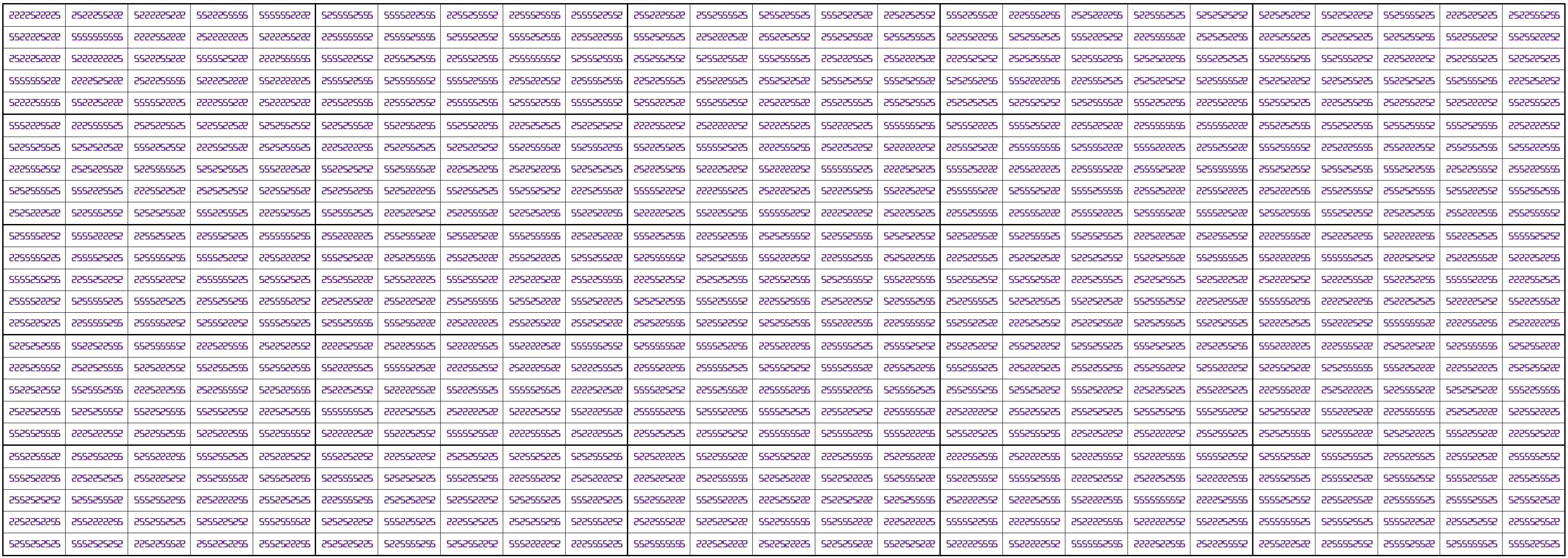
It is universal pandiagonal magic square with magic sums:
S125×25(2,5):=98888888879 and S225×25(2,5):=95555555546
There are two magic sums. The first one is for the original and upside-down, while the second sum for the mirror looking case. Blocks of order 5 are pandiagonal magic squares with different magic sums.
Upside-Down Magic Square with 2-Digits (6,9)
Example 7: Pandiagonal Magic Square of Order 25

It is upside-down pandiagonal magic square with magic sum:
S25×25(6,9):=98888888879.
Blocks of order 5 are pandiagonal magic squares with different magic sums.
d) 12-Digits Cell Entries:
Universal Bimagic Square with 2-Digits (1,8)
Example 8: Universal Pandiagonal Bimagic Square of Order 25

It is upside-down pandiagonal bimagic square with magic and bimagic sums:
S25×25(1,8):=14794790205195,
Sb25×25(1,8):=11527169460366128144971255.
Blocks of order 5 are pandiagonal magic squares with equal magic sums:
S5×5(1,8):=2958958041039.
Universal Magic Square with 2-Digits (2,5)
Example 9: Universal Pandiagonal Bimagic Square of Order 25

It is universal pandiagonal bimagic square with magic and bimagic sums:
S25×25(2,5):=10705703738730,
Sb25×25(2,5):=5093578210752809098589610.
Blocks of order 5 are pandiagonal magic squares with equal magic sums:
S5×5(2,5):=2141140747746.
Upside-Down Bimagic Square with 2-Digits (6,9)
Example 10: Upside-Down Pandiagonal Bimagic Square of Order 25

It is upside-down pandiagonal bimagic square with magic and bimagic sums:
S25×25(6,9):=21816814849830,
Sb25×25(6,9):=19548030916765021312550250.
Blocks of order 5 are pandiagonal magic squares with equal magic sums:
S5×5(6,9):=4363362969966.
References
- Inder J. Taneja, Universal and Upside-Down Magic Squares of Orders 3 to 6, Zenodo, November 05, 2024, pp. 1-61, https://doi.org/10.5281/zenodo.14041149
- Inder J. Taneja, Universal and Upside-Down Magic Squares of Orders 7 to 10, Zenodo, November 05, 2024, pp. 1-120, https://doi.org/10.5281/zenodo.14041164
- Inder J. Taneja, Universal and Upside-Down Magic Squares of Orders 11 to 15, Zenodo, October 06, 2024, pp. 1-141, https://doi.org/10.5281/zenodo.14041168
- Inder J. Taneja, Universal and Upside-Down Magic Squares of Order 16, Zenodo, October 16, 2024, pp. 1-28, https://doi.org/10.5281/zenodo.13942620
- Inder J. Taneja, Universal and Upside-Down Magic Squares of Order 20, Zenodo, October 20, 2024, pp. 1-56, https://doi.org/10.5281/zenodo.13958700.
- Inder J. Taneja, Universal and Upside-Down Magic Squares of Order 21, Zenodo, October 23, 2024, pp. 1-49, https://doi.org/10.5281/zenodo.13982859
- Inder J. Taneja, Universal and Upside-Down Magic Squares of Order 24, Zenodo, October 29, 2024, pp. 1-82, https://doi.org/10.5281/zenodo.14004788
- Inder J. Taneja, Universal and Upside-Down Magic and Bimagic Squares of Order 25, Zenodo, October 30, 2024, pp. 1-53, https://doi.org/10.5281/zenodo.14014851.
Note:
The result for the magic squares of orders 17, 18, 19, 22 and 23 are missing. The reason is that the numbers 17, 19 and 23 are prime numbers. It can be done similar to orders 11 and 13. The other numbers missing are of orders 18 and 22. It can be done similar to orders 10 or 14.
